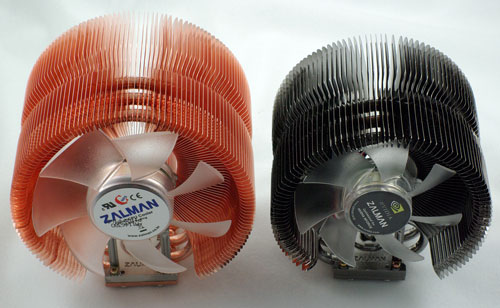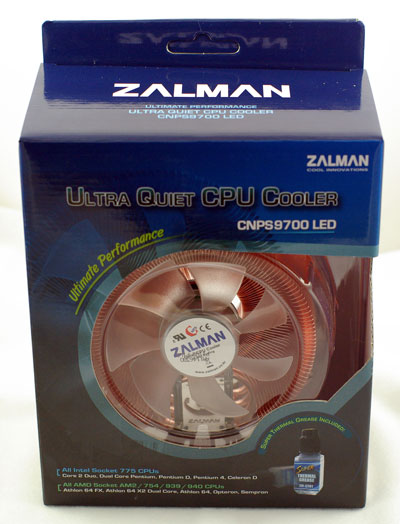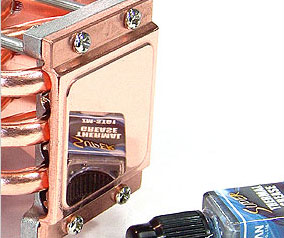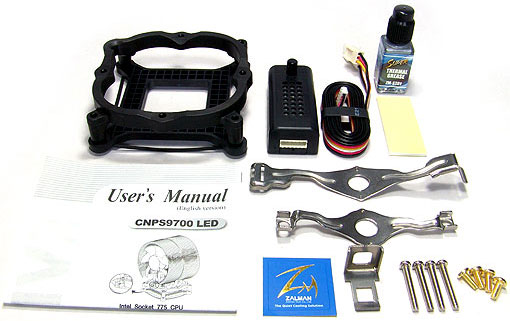The Zalman Twins: 9500 & 9700 Air Tunnels
by Wesley Fink on February 19, 2007 12:40 AM EST- Posted in
- Cases/Cooling/PSUs
Zalman 9700
The Zalman CNPS9700 is basically an oversized 9500, with a larger 110mm fan and a greater surface area of copper fins for cooling.
The size difference is pretty clear in this picture of the 9500 and 9700 side by side. The increase in size and copper also raises the cost. Where the 9500 series sells for around $60, the 9700 retails for about $75.

Packaging for the 9700 is about the same as the 9500. Zalman uses blue for the universal mount and Intel mount coolers, and green to designate AMD coolers. We would like to extend a thank you to Frozen CPU for providing the Zalman CNPS9700 for review.

Few can complain about the polish of the copper mounting surface of the 9700. The 9500 was very similar, with a flat high polish pad that mates to the CPU. Mounting of the 9700 is exactly like the 9500. The same adapters and plates will work on either CPU cooler.

The 9700 includes all the same parts as the 9500 LED plus an AM2 adapter. It also includes the Zalman Fan Mate 2 fan controller. The 9700 can mount Socket 775, AM2, 754, 939, and 940. However, it drops support for Socket 478, which is now three generations back on the Intel tree. Also added is a bottle of Zalman Super Thermal Grease.
Zalman Super Thermal Grease
Included in the CSN9700 kit is a bottle of Zalman Super Thermal Grease with a brush in the cap to make application easier.
| Zalman Super Thermal Grease Specifications | |
| Type | Non-curing compound |
| Capacity | 3.5g |
| Specific Gravity | 2.42 |
| Temperature Stability | -40C-150C (-40F-302F) |
Specifications
Our test system is Intel Socket 775, but the Zalman CNPS9700 LED will mount on all current CPU sockets. All the needed hardware is included to fit the variety of supported sockets.
| Zalman CNPS9700 LED Specifications | |
| Heatsink | |
| Dimensions | 90(L) X 124(W) X 142(H) mm |
| Weight | Heatsink: 690g, Total (including fan): 764g |
| Base Material | Pure Copper and Aluminum |
| Dissipation Area | 5,490 cm2 |
| Fan | |
| Fan Size/Weight | 110 mm, 74g |
| Bearing Type | 2 Ball-Bearing |
| Speed - Silent Mode | 1,250RPM +/- 10% |
| Speed - Normal Mode | 2,800RPM +/- 10% |
| Noise Level - Silent Mode | 19.5dB +/- 10% |
| Noise Level - Normal Mode | 35dB +/- 10% |
The main difference between the Zalman 9700 and the 9500 is size and weight. The 9700 is 142mm tall compared to the 9500 height of 125mm. This 17mm height difference will matter to some with smaller cases, but neither of these two Zalman coolers is truly small. They are generally not suitable for small, flat Media PC cases or modular cases designed for rack mounting.
The 9700 also weighs 764g, compared to the 530g of the 9500. While the motherboard mounting method may handle the 530g weight just fine, you should be careful with the heavier 9700. At almost two pounds this is a heavy heatsink and the plastic mounting plates allow flex - they are not rigid like some of the metal plates used on competing large CPU coolers. It is probably not a good idea to use the 9700 on a PC that will be moved frequently, such as a LAN Party PC. Carrying around a mounted heavy cooler like the Zalman 9700 could be asking for trouble.










50 Comments
View All Comments
Scorpion - Wednesday, February 21, 2007 - link
Page 5 states:So for 30 minutes, you capture 450 data points. It's expected that the data will ramp up over the 30 minute interval and reach an approximately linear stability region towards the end.
I have a problem with your measurement evaluation and findings. I do not think this is a very conclusive or accurate measurement and evaluation criteria. This information could be useful, yes, but only as an additional evaluation criteria.
All tests need a good, quantifiable evaluation metric. The "goodness" of a test is only as good as that metric. And I conclude that what you've chosen is a poor metric. Your posterior evaluation is highly influenced by noise. The maximum could be the result of a large noise addition to the measurement.
A better choice would have been to analyze the data results from all the tests to determine a stability region in the latter part of the data measurements, for all tests. Treat the data in that region as a random variable and take the expectation over that region. That would give you a much better evaluation criteria. You could also compute the variance of the data in this region to determine how stable the performance is for each cooler. This could also be a useful metric, although I know that this may not mean much to your typical audience. Another interesting metric would be to evaluate the other region in the data, in order to measure how quickly temperature ramps up. Or put into other words, how quickly each fan responds to temperature changes.
I'm saddened to see a good and useful article brought down by it's poor evaluation criteria. It effectively reduces the confidence in your conclusions.
Wesley Fink - Friday, February 23, 2007 - link
We try to answer two questions in our cooling tests. First, most users beef up cooling to improve overclocking. We determine the highests stable overclock using a standard CPU/test bed by finding the overclock the cooler can maintain for 30 minutes of looping a demanding game. The highest OC is a very good measure of the effectivenes of the cooler and is compared to other coolers. We also measue and report the highest temperature in this load condition - and yes it does spike up and level off as you suggest. We haven't seen the huge spikes you might fear are there in our test data. Temps rise quickly and stabilize at the temp we report. This is a good indication of cooler efficiency.Second, some users beef up cooling to reduce noise. We also report the lowest noise measurements for the cooler we are testing.
Your suggestions would provide much useful information, and we may add additional testing in the future. However, for now, we are trying to cut through all the hype surrounding cooler testing and provide as much useful info to our readers as possible in a timely manner. We are comfortable that we answer the two questions above in our cooler reviews, and those are the main questions our readers are always asking us about cooler performance.
cyberkost - Tuesday, February 20, 2007 - link
I did not quite get the methodology of the noise level comparisons...Were the coolers required to provide "same cooling performance" (e.g., same CPU temperature some long time into running some stress test)? It does not seem that they were. I'm worried about Anandtech intending to adapt the noise-comparison technique described in this article. The proper technique (IMHO) would be:
1) install cooler
2) run a stress test
3) dial cooler RPM till a (judiciously) chosen (same for all coolers) CPU temperature is achieved (say 40C) in a stable manner
4) record the noice level and put it on the comparison chart
strikeback03 - Tuesday, February 20, 2007 - link
Reading the respective reviews, it would appear that at stock speeds (and possibly some others) that the Katana, for example, does not get as cool as the Tuniq even when the Katana is at max RPM and the Tuniq at minimum.rjm55 - Tuesday, February 20, 2007 - link
Can you please review the Austrian Noctua NH-U12. I've seen good and bad reviews and I want to see what you find.gloutch - Tuesday, February 20, 2007 - link
The performance of those headpipes coolers is reduced if not properly oriented.SO: What was the position of the Zalmann coolers during the test ????????????????????
Wesley Fink - Tuesday, February 20, 2007 - link
From page 4 - CPU Cooling Test Configuration:"All cooling tests are run with the components mounted in a standard mid-tower case. The idle and stress temperature tests are run with the case closed and standing as it would in most home setups. We do not use auxiliary fans in the test cooling case, except for the north bridge fan attached to the 680i for overclocking."
As an aside we have found the impact of heatpipe cooler orientation to be pretty small - we just don't leave that test criteria to chance. An article on the impact of heatpipe cooler orientation on performance could be interesting.
orion23 - Monday, February 19, 2007 - link
Hi!Thanks for this awesome review. Only 2 top coolers left to review:
Thermalright Ultra 120
Scythe Infinity!
It is great to see Anandtech starting to review other PC components such as CPU Coolers and RAM. Things can be very quiet around here unless a new CPU, GPU or MotherBoard comes along......
Hopefully this is only the beginning of a new Anandtech that will review other important PC components such as the PSU, CPU Coolers, (AIR / Water), Fan Controllers...
It wouldn't hurt to have more stuff to read around here!
DrMrLordX - Tuesday, February 20, 2007 - link
Actually, the SI-128 and Noctua NH-U12F probably deserve a review at some point as well. Maybe even the Scythe Mine? The Mine can supposedly outperform the Ninja when using high-cfm fans, but your guess is as good as mine when it comes to actually mounting a 120mm fan on the Mine that normally takes a 100mm fan.DrMrLordX - Tuesday, February 20, 2007 - link
Woops, I forgot the Big Typhoon and Big Typhoon VX.